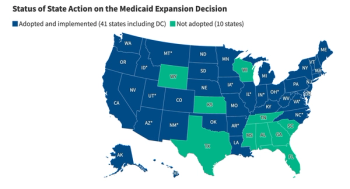
Considering the Ideal Role for Non-Emergency Medical Transportation in Addressing SDoH in Medicaid and Medicare Populations
Medicare and Medicaid programs that serve the most-vulnerable Americans facing SDOH barriers can be major facilitators of appropriate non-emergency transportation to non-medical sites. But how do we determine what is appropriate, and what do we know about transportation services to non-medical sites today?
Non-emergency medical transportation (NEMT) has been a part of the Medicaid program since its establishment. It was first codified in regulation in 1973, and Congress reiterated that NEMT is a mandatory Medicaid benefit in the 2020s Consolidated Appropriations Act. Medicare generally does not provide non-emergency transportation, with the exception of beneficiaries who are unable to be transported in any vehicle other than an ambulance.
Health plans that participate in Medicare Advantage (MA) and capitated providers such as Accountable Care Organizations can choose to offer non-emergency transportation but are not required to do so. Whether covered by Medicaid or Medicare, most non-emergency transportation is to medical sites; transportation to non-medical sites is uncommon.
The growing focus on the social determinants of health (SDOH) increases attention on the appropriate role of transportation to both medical and non-medical sites. While there is a body of research on the value of transportation to medical care, there is limited research on transportation’s role in supporting access to non-medical sites (e.g., grocery stores, fitness centers, social services) and on how improved access to non-medical needs via transportation services may ultimately improve people’s health.
Medicare and Medicaid programs that serve the most-vulnerable Americans facing SDOH barriers can be major facilitators of appropriate non-emergency transportation to non-medical sites. But how do we determine what is appropriate, and what do we know about transportation services to non-medical sites today?
Based on a survey of 91 organizations, the Medical Transportation Access Coalition (MTAC) assessed (1) the value of transportation for vulnerable Medicare beneficiaries by analyzing claims from a regional MA plan and (2) the variety of non-medical sites that Medicaid and Medicare plans and providers support with transportation. By undertaking two distinct but complementary analyses, we highlight the role that non-emergency transportation could play in addressing the SDOH needs of Medicare and Medicaid beneficiaries.
Medicare Advantage Claims Analysis
Actuaries analyzed claims from a regional MA plan with a large Dual Eligible Special Needs Plan (D-SNP) and general-market MA Health Maintenance Organization (HMO) plans. These plans have a NEMT benefit — with the MA plan benefit augmenting Medicaid’s NEMT benefit for dual-eligible beneficiaries. The analysis compared transportation utilizers against non-utilizers on a variety of medical and pharmacy cost-and-use data elements.
Transportation positively correlates with primary care utilization. Transportation users see their primary care physicians 1.5 times more than non-utilizers do.
Transportation utilizers tend to be sicker than non-utilizers are. This assertion is based on the Hierarchical Condition Category codes assigned to them as part of the MA risk adjustment program. The average risk score of transportation utilizers is 1.97 vs. 1.35 for non-utilizers, based on the most recent complete risk adjustment coding year (2019). This demonstrates that NEMT expenditures cluster toward members with the greatest medical needs.
SDOH Transportation Survey
MTAC, with the help of the coalition’s allied members, conducted a first-of-its-kind survey of organizations that provide transportation to Medicare and Medicaid beneficiaries.We received 91 responses from organizations that provide transportation to Medicare or Medicaid beneficiaries.
Forty-three responding organizations reported that they provide non-medical transportation to Medicaid beneficiaries. Respondents provided Medicaid beneficiaries with non-medical transportation for as many as 500,000 and as few as 60. Twenty-seven survey respondents provided non-medical transportation to Medicare beneficiaries for as many as 500,000 and as few as 100 beneficiaries.
Importantly, there is no single “consensus” destination served by a majority of responding organizations. Permissible sites for MA plans trended toward destinations with an obvious correlation with physical health (e.g., grocery stores, fitness centers); Medicaid destinations had a broader focus that often included social services and vocational destinations.
Organizations frequently put utilization limits on their non-medical transportation services. For example, 48% of Medicare respondents placed limits on the number of round trips per period, and 33% used prior authorization to contain unnecessary trips. Among Medicaid plans, 41% of respondents opted to implement tools such as prior authorization, while 34% chose to limit rides based on a maximum number of trips per time period.
This study highlights how non-emergency transportation helps vulnerable people access healthcare and essential services (e.g., grocery stores, fitness centers, social services) and is a driver of people’s health and well-being. Over time, additional research will be needed to understand how these sorts of interventions directly lead to better health outcomes and impact overall spending within public insurance plans. If non-medical transportation improves the health and well-being of Americans, policymakers should consider the case for financing comprehensive, appropriate transportation based on medical and social needs.
Vincent Giglierano is a Faegre Drinker Consulting advisor.
Michael Adelberg is a Faegre Drinker Consulting principal.
Krisda H. Chaiyachati is an assistant professor of medicine at the University of Pennsylvania Perelman School of Medicine.
Newsletter
Get the latest industry news, event updates, and more from Managed healthcare Executive.





















































